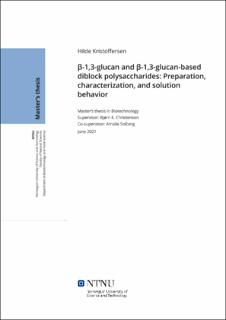| dc.contributor.advisor | Christensen, Bjørn E. | |
| dc.contributor.advisor | Solberg, Amalie | |
| dc.contributor.author | Kristoffersen, Hilde | |
| dc.date.accessioned | 2022-02-01T18:28:43Z | |
| dc.date.available | 2022-02-01T18:28:43Z | |
| dc.date.issued | 2021 | |
| dc.identifier | no.ntnu:inspera:75551004:15930758 | |
| dc.identifier.uri | https://hdl.handle.net/11250/2976481 | |
| dc.description.abstract | 𝛽-glukaner er en av de mest rapporterte biologisk aktive polysakkaridene og anses å ha et stort potensial i ulike industrier. Et vannløselig preparat av 𝛽-1,3-glukan med forgreninger koblet via 1,6-bindinger (SBG), opprinnelig isolert fra celleveggene til Saccharomyces cerevisiae, ble studert i denne oppgaven. Selv om SBG er vannløselig, har det en tendens til å aggregere sterkt i vandig løsning. Målet med denne masteroppgaven var å fremstille prøver av fullt løselig SBG ved terminal aktivering med det bifunksjonelle dioksyaminet propandiylbishydroksylamin (PDHA) og fremstilling av SBG-baserte blokkpolysakkarider.
SBG ble først aktivert ved terminal kobling til PDHA. Koblingen av dioksyaminet resulterte i en blanding av (E)- og (Z)-oksimer og 𝛽-N-pyranosid. Stabile sekundære aminer ble oppnådd ved reduksjon med 2-pikolinboran (PB). PDHA-aktivert SBG (SBG-PDHA) ble ytterligere separert og fraksjonert ved eksklusjonskromatografi (SEC) for å oppnå prøver med smalere molar massefordeling. Fraksjoner av SBG-PDHA samlet fra separasjonen ble studert ved SEC med fler-vinklet lysspredningsdetektor (SEC-MALS) og en viskositetsdetektor både med og uten forbehandling med høy temperatur. Det sterkt aggregerende materialet kunne ikke løses opp som enkeltkjeder i vann etter terminal aktivering med PDHA. Imidlertid kunne aggregerende SBG-PDHA løses opp som enkeltkjeder i dimetylacetamid (DMAc) som inneholdt 0.9 % LiCl.
Blokkpolysakkarider ble fremstilt fra PDHA-aktivert SBG ved å feste på dekstran og alginat som den andre blokken. Kobling av blokkende gjennom deres reduserende ende sikrer opprettholdelse og tillater kombinasjon av deres iboende egenskaper. Kinetiske studier for koblingen av dekstran og alginat til PDHA-aktivert SBG er presentert. Koblingen av alginat viste seg å være raskere og ga et høyere utbytte av diblokker sammenlignet med koblingen av dekstran. Protokollene etablert for framstilling av korte SBG-b-dekstran og SBG-b-alginat diblokk-oligosakkarider ble brukt til å fremstille diblokker med lengre kjedelengder. Kobling av dekstran og alginat til PDHA-aktivert SBG i dette tilfellet viste seg å ikke øke løseligheten til SBG nok til å motvirke aggregeringen. Å øke kjedelengden til den andre blokken kan være svaret for å oppnå fullt løselig SBG. | |
| dc.description.abstract | 𝛽-1,3-glucans are one of the most widely reported bioactive polysaccharides with potential use in various industries. A water-soluble preparation of 𝛽-1,3-glucan with 1,6-linked branches (SBG), originally isolated from the cell walls of Saccharomyces cerevisiae was studied in this thesis. Although being water-soluble, SBG tend to aggregate strongly in aqueous solution. The aim of this master thesis was to prepare samples of fully soluble SBG by terminal activation with the bifunctional dioxyamine propanediylbishydroxylamine (PDHA) and preparation of SBG-based block polysaccharides.
SBG was first activated by terminal conjugation to PDHA. Conjugation of the dioxyamine resulted in a mixture of (E)- and (Z)-oximes and 𝛽-N-pyranoside. Stable secondary amines were obtained by reduction with 2-picoline borane (PB). PDHA-activated SBG (SBG-PDHA) was further separated and fractionated by size exclusion chromatography (SEC) to obtain samples of narrower molar mass distributions. Fractions of SBG-PDHA collected from the separation were studied by SEC with multiangle light-scattering (SEC-MALS) detector and a viscosity detector both with and without pretreatment at high temperature. The strongly aggregating material could not be dispersed as single chains in water following terminal activation with PDHA. However, aggregating SBG-PDHA could be dispersed as single chains in dimethylacetamide (DMAc) containing 0.9 % LiCl.
Block polysaccharides were prepared from PDHA-activated SBG by attaching dextran and alginate as the second block. Coupling of the blocks through their reducing ends ensures retention and allow combination of their intrinsic properties. Kinetic studies for the conjugation of dextran and alginate to PDHA-activated SBG are presented. Attachment of alginate turned out to be faster and resulted in higher yields of diblocks compared to the attachment of dextran. Protocols established for the preparation of short SBG-b-dextran and SBG-b-alginate diblock oligosaccharides were used to prepare diblocks of longer chain lengths. Attachment of dextran and alginate to PDHA-activated SBG in this case did not appear to increase the solubility enough to counter the aggregation of SBG. Increasing the chain length of the second block might be the answer to obtain fully soluble SBG. | |
| dc.language | eng | |
| dc.publisher | NTNU | |
| dc.title | β-1,3-glucan and β-1,3-glucan-based diblock polysaccharides: Preparation, characterization, and solution behavior | |
| dc.type | Master thesis | |
